Eleven Decades of Drury Ranching
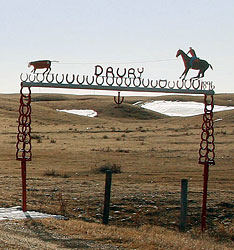 |
|
Photo by Gary Houston |
In Connie Kaldor’s song Sky with nothing to get in the way, the line “you’re lucky if you’ve seen the Cypress Hills” comes to mind as you travel Highway # 21 south of Maple Creek, Sask., gradually climbing the slopes for nine miles. Immediately after turning left at the Drury Ranch gate sign, the rush of everyday life is left behind as you follow a three-mile ribbon of road where native prairie grass fans out in all directions as far as the eye can see. The ranch buildings are neatly tucked between folds of hills where the east and west branches of Maple Creek run on either side.
This ideal ranch location caught Thomas (Tom) A. Drury’s attention in 1896 when he homesteaded on NW 26-9-26-W3. Noteworthy is the fact there have been many Joseph, Thomas and William Drurys. The family tree dates back to 1630, Kenilworth, Warwickshire, in the center of England.
Tom married Grace (Briggs); they had one daughter, “Bunny”, and following Tom’s death from the 1918 flu epidemic, Grace then married Joseph (Joe) Stanley Drury, a nephew of Tom’s and together they had five more children. Over the years, two of their sons, Barry and William H. “Bill” took up ranching; more land was added and the ranch was operated as J. S. Drury & Sons.
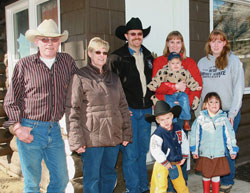 |
|
Photo by Gary Houston |
Barry and Phyllis (Hoffman) were married in 1952. They built their first home by adding onto one end of an old army building moved out from Maple Creek and used as a shop. In 1966, when the senior Drurys retired to town, Barry and Phyllis, with their children, Cindy, William James (Bill), and Johanna moved into Joe and Grace’s home. By meandering past the horse barn built in 1943 with logs from the hills, and heading southeast, one arrives where Barry and Phyllis built their new home in 1979.
Barry’s brother Bill married Una Gaugran, an Irish nurse. By the time their son, John was fifteen, both his parents had died. John then lived with Barry and Phyllis but sadness struck again when Phyllis passed away in 1983. John stayed with Barry, finished school, then moved back to his parents’ home. He remained there until 2000 at which time he moved his family west of Maple Creek. John continues working with Barry and Bill and manages the feedlot west of town on Fish Creek, where the calves are taken once they are weaned.
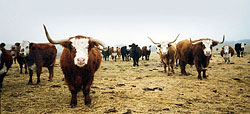 |
|
Photo courtesy of Drury family |
At age 15, Barry’s son, Bill, quit school and came home to ranch. As a young lad, he spent a lot of weekends with his grandfather, Bill Hoffman, who was a mechanic during the week at the Ford garage and a well-known horse trainer and trader on weekends. Grandpa taught Bill a lot about horses and on one occasion he gave Bill a Shetland pony. Bill and his chum, Ken Gold, about 13 and 14 respectively at the time, hitched Smoky the Shetland to a two-wheeled cart and travelled along the highway for several miles before heading across country. No one at home knew anything about this, so it was quite a surprise when Smoky and the boys arrived. Smoky lived to a ripe old age of 35. Hanging in the entry of Malinda (Rud) and Bill’s home is a metal key chain rack, crafted by Barry, and dedicated to Smoky.
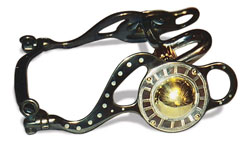 |
|
Photo courtesy of Drury family |
Malinda worked at Hutchings & Sharp’s western store in Maple Creek following her marriage to Bill in 1974. Bill’s grandmother, Hannah Hoffman, managed the store and it was here Bill met well-known saddlemaker, Ken Wright of Piapot, Sask. Bill got some pointers from Ken and was soon making leather chaps.
In 1979, Bill and Malinda moved into the ranch house originally built in 1932. Over the years they have renovated and added personal touches to this comfortable home where visitors immediately feel welcome.
There have always been hired men at the Drury ranch. At one time women weren’t allowed at the corrals but this has changed. Cooking included preparing meals and taking them to where the men were working cattle. One extremely cold fall day, a busy two-year-old kid locked all the food inside the truck. Now, the riders either come home to eat or they pack a lunch.
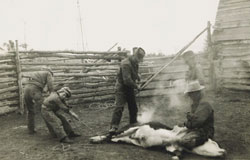 |
|
Photo courtesy of Drury family |
In 2005 Bill and Malinda’s son-in-law, Donald Knight (Lawrence), married to their daughter Jennie, quit his job as a mechanic and began working at the ranch. The couple lives in Maple Creek with their sons, William and Mathew, where Jennie works for Midwest Surveys. Rayna, Bill and Malinda’s younger daughter, works in File Maintenance at the Southwest Co-op and lives in Maple Creek with her daughter, Ray-Anna.
Bill’s passion for horses is no surprise as horses have and continue to be an important part of Drury history. Bill’s great uncle, Russell “Buck”, participated in the 1924 Imperial Rodeo at Wembley, England, one of only seventeen Canadian cowboys. In 1972, Bill’s sister, Cindy, went with neighbours Jean and Eunice Garissere to the National Rodeo Finals in Oklahoma City, Okla. Cindy entered a draw and won a papered Appaloosa colt. She could have taken money but declined. Area rancher Bill Gilchrist and Jean arranged for the colt to catch a ride to Billings with the rodeo rough stock. Bill Gilchrist supplied the car for Jack McDougald, Danny Udal and Bill Drury to travel to Billings where they picked up a new horse trailer and the colt. It ended happily, with Bill training Okie to become a first rate working ranch horse.
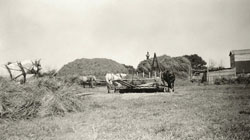 |
|
Photo courtesy of Drury family |
Bill Drury, quiet, talented and extremely modest, has an air of gentleness about him. Donald Knight says it’s something to see Bill stand out in the middle of the pasture, whistle, and have the horses all racing towards him. As Bill says, “We don’t own a four-wheeler; everything we do, we do with a horse.”
Malinda says Bill’s horses are calm and some are comical; like Roger, one of three Parsonage horses Bill bought as colts and trained. She says, “Roger has an understanding”, a knack of posing for pictures, pulling nails out of buildings with his teeth and adapting his behaviour to who can ride and who cannot.
Creative craftsmanship flows through the Drury generations. Bill’s grandfather, Joe, was a talented blacksmith. He also had his steamship papers and he drove a steam engine to plow some of the PFRA hay flats west of town. Barry and Bill both have workshop/cabins they were able to purchase from Cypress Hills Park for $550 each. Whether it’s a metal gate sign, an oak bookcase or a hand-tooled leather breast strap, Bill can make it. Regarding his horsehair hitching, he says, “I bought a little book and got started.” People have requested horsehair hatbands, also earrings, with mane and/or tail hair from a favourite old horse.
Harvey Peters is the proud owner of a Visalia-style bit crafted by Bill. The side conchos have a brass centre mounted on silver (engraving done by Bill Gilchrist), the shanks have silver inlay and overlay. Bill’s handcrafted headstall completes this masterpiece. Bill also rebuilt his grandfather’s saddle and an army saddle his sister bought for a dollar. Bill not only built, but designed from scratch, a saddle for his cousin. His stitching is done entirely by hand using an awl, sharp needle and pliers. He stamps his leather goods with a bear paw and his initials.
Malinda, in addition to putting together a pictorial history of Bill’s crafts, has had her landscape photos featured on a company calendar. As well, Jennie paints and Rayna sketches.
 |
|
Photo courtesy of Drury family |
Back in the sixties, Joe Drury ran a herd of top-notch horned Herefords. Later, Charolais bulls were introduced. Some calving problems resulted which led the Drurys to start using Beef Booster bulls along with Shavers, Angus and Herefords. Years ago they kept their calves until they were three years of age. Later on they sold two-year-olds and in the late seventies, switched to yearlings. Joe’s original Anchor over Bar brand, registered for either the right rib or right hip is still used today. Present herd conversation pieces include a donkey named Isaac, who hangs out with their horses, and four aging Highland-cross steers.
After talking to Barry and Bill about haying, seeing their well-repaired fences and how they manage their grass, one instinctively knows how important the landscape is to them. They truly are conscientious stewards of the grasslands, the kind of folks you want for neighbours.
Doris Bircham has been partnered with the same man, the same ranch and the same prairie wind forever in the Cypress Hills of southwestern Saskatchewan. Her latest book of poetry, Where Blue Grama Grows, is published by Hagios Press.
















